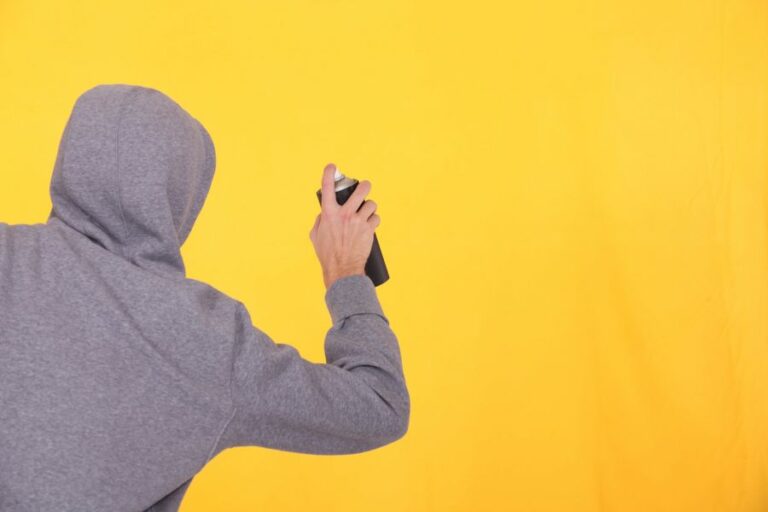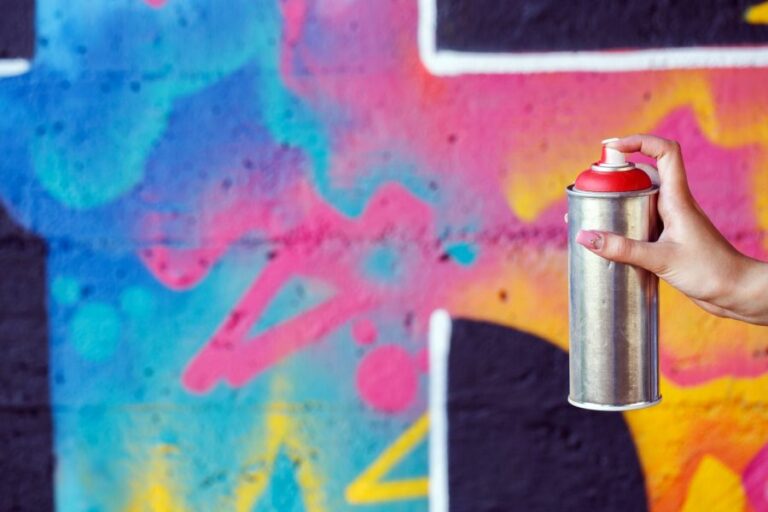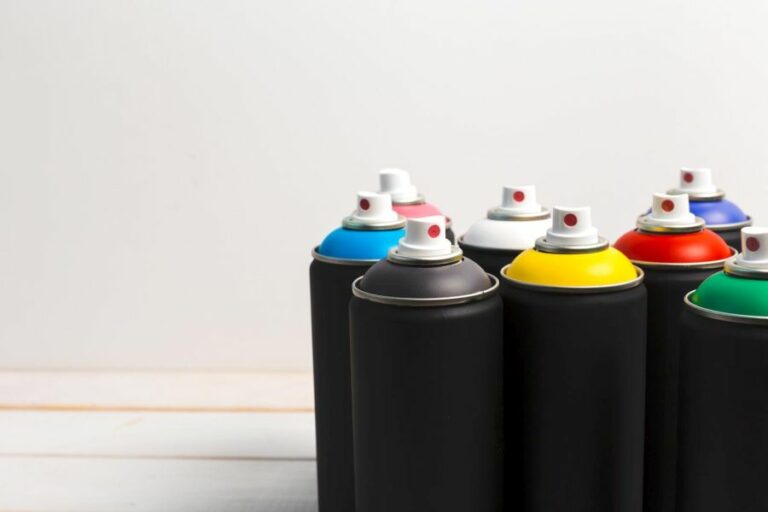UV Reactive Spray Painting Techniques
Looking to add a vibrant touch to your artwork that comes alive under ultraviolet light? You’ve come to the right place! We’re excited to show you some amazing UV-reactive spray painting techniques that will set your art apart from the rest. With our help and expertise, you’ll have no trouble mastering these skills, leaving everyone in awe of your creative genius.
UV reactive spray painting techniques:>
UV reactive spray painting uses paint that reacts to ultraviolet light, creating fluorescent or glowing effects. Essential techniques include surface preparation, layering, blending, and shading, using stencils and masks, experimenting with textures, and ensuring proper lighting. Safety precautions, such as working in well-ventilated areas and wearing protective gear, are crucial.

Delve into the world of UV reactive spray painting techniques and discover how to make your artwork come to life under black light. We’ve got all the tips, tricks, and guidance you need to create glowing masterpieces. Keep reading to take your creative skills to the next level!
Contents
- 1 Techniques for UV Reactive Spray Painting
- 2 Utilizing UV Reactive Spray Paint: A Guide
- 3 UV Reactive Paint: An Overview
- 4 Can UV Reactive Paint Create a Glow-in-the-Dark Effect?
- 5 Identifying Paint Types Visible under Blacklight
Techniques for UV Reactive Spray Painting
Discovering the world of ultraviolet (UV) reactive spray painting is an exciting venture that can take your artwork to a whole new level of creativity.
• What is UV Reactive Spray Paint?
UV reactive spray paint is a type of paint that reacts to ultraviolet (UV) light, causing it to fluoresce or glow. This effect can create stunning visual contrasts and captivating displays of color, especially when used alongside traditional spray paint or in dark environments.
As an artist, using UV reactive spray paint is ideal for adding a unique touch to your artwork and can be used on various surfaces, including canvas, metal, and wood. The paint’s versatility can bring a dynamic aspect to your pieces that will set them apart from others.
• UV Reactive Spray Painting Tips and Techniques
1. Preparing the Surface
Before diving into the creative process, it is essential to prepare the surface you will be working on. Clean the surface thoroughly, removing any dirt or grease that may be present. For better adhesion, consider lightly sanding the surface for a smoother finish.
Once the surface is ready, apply a primer designed for the surface material you are working on.
2. Layering Techniques
When working with UV reactive spray paint, layering is key in creating depth and contrast in your artwork. Begin with a solid base layer of a non-reactive or conventional spray paint color, which will serve as the foundation of your piece.
Next, apply layers of UV reactive spray paint colors on top of the base layer, working in thin, even coats. This will allow the UV paint to adhere properly to the base layer and create a smoother overall texture. Be patient and take your time with this process to achieve the desired effect.
3. Blending and Shading
Achieving a seamless blend of colors is crucial in creating a harmonious balance in your artwork. Start by applying the darker UV reactive colors to your piece’s recessed areas and gradually work your way to the lighter colors on the more prominent areas.
Utilize a soft brush to gently blend the colors together, creating a smooth transition between shades.
To add depth and dimension to your artwork, consider incorporating shading techniques by using a mix of UV reactive and non-reactive spray paint colors. This can bring a whole new level of visual interest to your piece.
4. Stencils and Masks
Creating intricate designs and patterns can be made easier by using stencils and masks. There are various types of masking materials available, including adhesive-backed stencils, masking tape, or even plastic wrap. For inspiration on stencil designs, consider browsing online resources like Stencil Revolution.
To effectively use stencils and masks, adhere them to your artwork’s surface and apply the UV reactive spray paint colors in thin, even coats. Be careful not to overspray or allow the paint to seep underneath the stencil, which can result in smudged or blurred designs.
5. Experimenting with Textures
UV reactive spray painting is all about creativity and experimenting with different textures to bring your artwork to life. You can achieve various effects by spraying different amounts of paint or changing the distance from which you spray.
Some artists also use tools such as sponges or brushes to manipulate and blend the paint on their surfaces.
When experimenting with textures, bear in mind that it may take some trial and error to achieve your desired look. Always practice on a smaller scale or test piece before committing to the main artwork.
6. Proper Lighting
One of the most important aspects of UV reactive spray painting is ensuring proper lighting during and after the painting process. Utilize UV lamps or blacklights to illuminate your artwork during the painting process to get an accurate representation of how the colors will react under UV light.
Additionally, display your finished piece under UV lighting to allow the stunning visual contrasts and glowing effects to truly shine.
• Safety Tips
Working with spray paint, particularly UV reactive varieties, requires attention to safety procedures. Be sure to work in a well-ventilated area and wear a respirator mask to protect yourself from potentially harmful fumes.
Protective gloves and goggles are also recommended to reduce the risk of skin and eye irritation.
Before using any spray paint, read the label for application instructions and specific safety precautions. Some UV reactive spray paints may be labeled as “for professional use only” and require special handling by trained personnel.
In conclusion, UV reactive spray painting offers artists a unique opportunity to create artwork that truly stands out from the rest. By mastering the techniques discussed in this article and adhering to proper safety protocols, you can create captivating pieces that will leave a lasting impression on viewers.
Experiment with different textures, patterns, and color combinations to bring your artistic vision to life under the captivating glow of UV light.
Utilizing UV Reactive Spray Paint: A Guide
If you’re looking to create eye-catching artwork or simply want to add a unique touch to any surface, UV spray paint is the answer. Also known as ultraviolet-responsive or fluorescent paint, UV spray paint contains pigments that glow when exposed to ultraviolet light.
• Understanding UV Spray Paint
UV spray paint differs from regular spray paint in that it contains special pigments that react to ultraviolet (UV) light, causing the paint to glow. This fascinating effect is excellent for various applications, such as wall murals, decorative signs, stage props, and more.
• Choosing the Right Materials
– UV Spray Paint
Quality is crucial when choosing a UV spray paint. Pick a paint with a high concentration of pigments to ensure a vibrant glow. There are numerous brands available, offering a wide range of colors to choose from.
When selecting your paint, make sure it is suitable for your desired surface, as some paints may only be designed for specific materials.
– Surface Preparation Materials
For the best results, you’ll need to prepare your surface before applying the UV spray paint. Gather the following materials:
- Sandpaper (various grits)
- Clean cloth or microfiber towel
- Primer
- Masking tape or painter’s tape
- Drop cloth or newspaper
– Safety Equipment
Spray paint fumes can be harmful, so always wear protective gear during the painting process. At a minimum, use a face mask or respirator specifically designed for aerosol spray paints. Additionally, wear gloves and protective eyewear to safeguard against paint splatter.
• Preparing the Surface for UV Spray Paint
To ensure your UV spray paint adheres correctly and lasts longer, follow these crucial surface preparation steps:
- Clean: Remove any dust, dirt, or grease from the surface using a clean cloth or microfiber towel. Ensure the surface is dry before proceeding.
- Sand: Using sandpaper, smooth the surface to create better adhesion for the paint. Begin with a coarse grit, transitioning to a finer grit for a smooth finish. Wipe away dust with a clean cloth.
- Mask: To prevent paint from spreading to unintended areas, apply masking tape or painter’s tape to cover any adjacent surfaces or sections you want to remain paint-free.
- Prime: Applying a primer will enhance paint adhesion and provide an even base for your UV spray paint. Follow the primer’s label instructions for application and drying times.
• Painting Techniques for UV Spray Paint
Follow these expert tips and techniques to achieve a professional-looking finish when applying your UV spray paint:
– Shake Well
Thoroughly shake your spray paint can for at least 1-2 minutes to ensure the pigments are well-mixed, which will result in a brighter and more consistent glow.
– Test Spray
Before applying paint to your desired surface, perform a test spray on cardboard or scrap material to gauge the paint flow and make any necessary adjustments to your technique.
– Maintain a Safe Distance
Hold your spray can approximately 8-12 inches from the surface. Spraying from a greater distance will prevent paint buildup, reducing the risk of drips and avoiding an uneven texture.
– Apply Multiple Thin Coats
For optimal color and glow, apply several thin coats of paint, allowing each coat to dry before applying the next. This technique will result in a more even finish and better adhesion to the surface.
– Use Even Strokes
When spraying, use a steady, even motion, overlapping each pass by about 50%. This technique will help ensure complete coverage and minimize the risk of streaks or spots.
• Curing and Finishing the UV Spray Paint
Closely follow the drying and curing times recommended by the manufacturer on the product label. In general, most UV spray paints will be dry to the touch within 30 minutes to an hour, but it can take up to 24 hours or more to fully cure.
Applying a clear coat or sealant specifically designed for UV spray paint will further protect your paint and enhance the fluorescent effect. Make sure your paint is completely dry before applying any clear coat or sealant.
• Final Thoughts
UV spray paint is a fantastic way to add a vibrant, glowing effect to any project. By following these recommendations and techniques, you’ll be well on your way to creating unique and captivating artwork that’s sure to impress.
Remember always to prioritize safety, thoroughly prepare your surface, and take your time to ensure a smooth, even finish. Happy painting!
Step | Description |
|---|---|
1 | Choose a suitable work area. Ensure that the space is well-ventilated and free of direct sunlight. |
2 | Protect the surfaces around your work area. Lay down drop cloths or newspapers to prevent unwanted paint residue. |
3 | Prepare your surface. Clean the surface you want to paint and allow it to dry completely. Prime your surface if necessary. |
4 | Shake the UV spray paint can for 1-2 minutes to ensure the proper consistency of the paint. This will help avoid clotting and improve the overall result. |
5 | Hold the can 10-12 inches away from the surface and apply the paint in smooth, even strokes. Use a back-and-forth motion for even coverage. |
6 | Allow the paint to dry for the time recommended by the manufacturer. Apply additional coats if necessary, allowing adequate drying time between coats. |
7 | Once the UV spray paint is completely dry, it’s ready for exposure to UV light. The paint will appear normal in regular light and will glow brightly under blacklight. |
UV Reactive Paint: An Overview
UV reactive paint, also known as ultraviolet or fluorescent paint, is a type of luminescent paint that reacts uniquely to ultraviolet (UV) light.
• Properties of UV Reactive Paint
UV reactive paint contains special pigments, usually phosphors or luminescent molecules, that absorb and emit light in the ultraviolet spectrum. These pigments can be derived from various sources, such as minerals or organic compounds.
– Absorption and Emission of Light
When exposed to ultraviolet light, the pigments in UV reactive paint absorb energy and become excited. They then release this energy as visible light, causing the paint to glow. This process is known as fluorescence.
Fluorescence is characterized by the ability of a substance to emit light shortly after absorbing it. In the case of UV reactive paint, this light emission is typically within the visible spectrum, creating vibrant and vivid colors that are not visible under normal lighting conditions.
– Colors and Intensity
The glow of UV reactive paint is directly related to the types of pigments used, as well as their concentration within the paint. Different pigments emit specific colors, such as bright blues, greens, yellows, oranges, and reds.
The intensity of the glow depends on several factors, including the type and concentration of the pigment, the thickness of the paint layer, and the power of the UV light source. High-quality UV reactive paint will generally produce a brighter and longer-lasting glow.
• Applications and Uses of UV Reactive Paint
There is a wide range of applications and uses for UV reactive paint in various creative, commercial, and industrial contexts.
– Arts and Crafts
UV reactive paint is a popular choice for artists and crafters to create special effects and unique visual displays. Its vibrant colors and glowing properties can be used to add depth and dimension to paintings, murals, sculptures, textiles, and other artistic projects.
– Entertainment and Events
In the entertainment industry, UV reactive paint is often used for creating visual effects in theatrical productions, concerts, and music festivals. Similarly, it is a popular choice for decorating and enhancing the ambiance at parties, clubs, and other social events that employ ultraviolet lighting.
– Advertising and Signage
Businesses may use UV reactive paint for creating eye-catching advertisements, logos, and signage that stand out under ultraviolet light. This can help increase visibility and create a unique branding opportunity for the business.
– Safety and Security
UV reactive paint can be used as a discreet marking system for identifying and tracking valuable assets, documents, or products. The invisible markings are only visible under ultraviolet light, making them difficult to detect and alter.
• Safety Concerns and Handling of UV Reactive Paint
As with any paint, it is essential to handle UV reactive paint responsibly and follow appropriate safety precautions.
– Skin and Eye Protection
While most UV reactive paints are non-toxic and safe to use, direct contact with skin and eyes should be avoided. Always wear gloves when handling the paint, and use eye protection if splashes are a potential risk.
– Ventilation
Ensure proper ventilation when working with UV reactive paint, especially in enclosed spaces. This will help prevent the buildup of potentially harmful fumes and ensure a safe working environment.
– Disposal
Dispose of UV reactive paint responsibly, following the guidelines and regulations of your local area. Do not pour paint down the drain, as this can contaminate water sources and harm the environment. Contact your local waste disposal facility for more information on proper disposal methods.
• Recommendations for Using UV Reactive Paint
Based on my personal experience, I recommend the following for getting the best results with UV reactive paint:
- Use a suitable UV light source: The quality and power of your UV light source will significantly impact the glow and appearance of your UV reactive paint. High-quality UV LED lights, blacklights, or UV tubes are recommended.
- Apply multiple layers: For a more vibrant and intense glow, apply multiple layers of UV reactive paint. Make sure each layer is dry before applying the next one.
- Work on a dark or neutral background: UV reactive paint will show up best on black or dark-colored surfaces. If working on a light or white background, consider using a dark primer or undercoat first.
- Seal with a clear coat: To protect the paint and increase its longevity, apply a clear topcoat or sealant after the paint has fully dried.
- Practice and experimentation: Like with any material, becoming proficient with UV reactive paint takes time and practice. Experiment with different techniques and applications to find your unique style and create stunning works of art.
Can UV Reactive Paint Create a Glow-in-the-Dark Effect?
UV reactive paint, also known as ultraviolet reactive paint or UV glow paint, is a fascinating and versatile product that reacts to ultraviolet (UV) light by emitting visible light, more commonly referred to as glowing.
• Understanding Ultraviolet (UV) Light and Fluorescence
To understand UV reactive paint, a basic understanding of UV light and fluorescence is essential. Ultraviolet light is a form of electromagnetic radiation that is not visible to the naked eye.
UV light exists in wavelengths ranging from 100 to 400 nanometers (nm), shorter than the human visual spectrum, which ranges from approximately 400 to 700 nm.
When certain materials are exposed to UV light, a phenomenon called fluorescence occurs. During fluorescence, a material absorbs photons (light energy) from UV light and releases this energy in the form of visible light. This results in the material appearing to glow in the dark when exposed to ultraviolet light.
• The Chemistry Behind UV Reactive Paint
The secret to UV reactive paint lies in the specific chemicals added to the paint, known as fluorophores. Fluorophores are specialized molecules with the ability to absorb UV light and emit visible light as a result.
When fluorophores are added to paint, they create the characteristic glow effect when exposed to UV light.
A common class of fluorophores used in UV reactive paint is phosphors. Phosphors are inorganic compounds, such as zinc sulfide and strontium aluminate, and may be doped with other elements, such as copper or europium, to enhance specific properties, such as glow duration and intensity.
• Identifying Primary UV Light Sources for UV Reactive Paint
UV reactive paint requires UV light to produce fluorescent light. There are several sources of UV light that can effectively activate the glowing effect of the paint. These are:
- Sunlight: Although mostly visible light, sunlight also contains a small percentage of UV radiation sufficient to activate UV reactive paint. However, due to atmospheric interference and other factors, sunlight may not be the most consistent or reliable source of UV light for regular use.
- Blacklight: A more controlled and popular option for providing UV light is the use of a blacklight. Blacklights emit a specific range of UV light, most commonly around 365 nm, designed to excite fluorophores without causing harmful effects to the human eyes or skin. For optimal results with UV reactive paint, I recommend using a blacklight as your primary UV light source.
• Types of UV Reactive Paint and Their Applications
UV reactive paint is available in various formulations depending on the desired effect and application. Some common types of these paints are:
- Acrylic-based UV reactive paint: This type of paint is generally water-based and can be applied to various surfaces, such as canvas, wood, paper, and plastics. It is ideal for creating artwork, signage, and decorative items.
- Fabric-based UV reactive paint: Formulated specifically for textiles, this type of paint is resistant to washing and resistant to fading. It is excellent for customizing clothing, costumes, and textile-based decorations.
- Body paint: As a non-toxic water-based formulation, UV reactive body paint is safe to use on skin and can be easily washed off with soap and water. Popular applications include face painting, body art, and makeup for parties, events, and festivals.
• Tips for Using UV Reactive Paint
To achieve the best results with UV reactive paint, consider the following tips:
- Use a primer: Applying a white primer to your surface before applying the UV reactive paint can enhance the brightness and intensity of the colors.
- Layering: Sometimes, several layers of paint can be necessary to obtain the desired brightness and intensity of color.
- Appropriate lighting: Ensure you have a suitable UV light source, such as a blacklight, to create the optimal glow effect.
- Proper drying and curing: Following the manufacturer’s instructions for drying and curing times is essential to achieving a durable and robust paint finish.
In conclusion, UV reactive paint is a versatile and creative medium with unique glow-in-the-dark properties resulting from its interaction with ultraviolet light.
Understanding the science and chemistry behind this paint, as well as following practical tips on usage, will enable you to create stunning visuals and effects in various applications. Experiment and enjoy the mesmerizing world of UV reactive paint!
Identifying Paint Types Visible under Blacklight
• Introduction: Blacklight Paint and its Uses
Blacklight paint, or fluorescent paint, is a special kind of paint that glows under ultraviolet (UV) light. This unique property makes blacklight paint useful in various applications, such as:
- Art installations
- Theater and stage performances
- Interior decoration
- Themed parties and events
- Safety markings
Knowing which types of blacklight paint are available on the market, and understanding their properties and appropriate uses, can help you make informed decisions when selecting the best paint for your needs.
• Types of Blacklight Paint
– Fluorescent vs. Phosphorescent Paint
There are two main categories of blacklight paint: fluorescent paint and phosphorescent paint. Fluorescent paint only glows under direct UV light exposure, while phosphorescent paint continues to glow after being removed from the light source, for a period of time.
Fluorescent Paint
Fluorescent paint contains pigments that absorb and emit light within the visible spectrum. When exposed to UV light, the paint’s pigments absorb the incoming light and re-emit it as visible light, causing the colors to appear vibrant and bright.
Fluorescent paint is commonly used for artistic projects, interior design, and safety markings.
Some examples:
- Acrylic-based fluorescent paint
- Water-based fluorescent paint
- Spray fluorescent paint
Phosphorescent Paint
Phosphorescent paint, also known as glow-in-the-dark paint, contains substances that can store energy when exposed to a light source, such as UV light. When the light source is removed, the stored energy is slowly released, causing the paint to emit a visible glow for a duration of time.
Phosphorescent paint is commonly used for:
- Art installations
- Stage and theater performances
- Safety signs and markings, particularly in areas prone to power outages
– Water-Based vs. Solvent-Based Blacklight Paint
Another factor to consider when choosing blacklight paint is the type of base used in the paint formula. Water-based and solvent-based paint options offer different properties that can affect the finished result.
Water-Based Blacklight Paint
Water-based blacklight paint typically offers the following benefits:
- Easy application and clean-up
- Faster drying time
- Low odor
- Non-toxic and environmentally friendly
- Can be used on a variety of surfaces, including paper, wood, and fabric
A popular choice for water-based blacklight paint is acrylic. Acrylic blacklight paint offers additional benefits, such as:
- Fast-drying and durable
- Can be thinned with water or acrylic mediums
- Versatile for use in many different applications
I recommend water-based blacklight paint for beginners, artists, and anyone looking for an easy-to-use, eco-friendly option.
Solvent-Based Blacklight Paint
Solvent-based blacklight paint typically offers the following benefits:
- More durable and long-lasting finish
- Can bond to a wider range of surfaces, including metal and glass
- Can withstand harsher conditions, such as outdoor environments and heavy foot traffic areas
However, solvent-based blacklight paint also has some potential disadvantages:
- Longer drying time
- Strong odor
- May require the use of solvents for clean-up
Solvent-based blacklight paint is suitable for more demanding applications or when a longer-lasting finish is needed.
• Selecting the Right Blacklight Paint
When selecting blacklight paint, it’s essential to consider the specific requirements of your project. Some important factors to consider include:
- The type of surface you’re working with
- The desired aesthetic and functional properties of the finished product
- The environmental conditions (e.g., indoors vs. outdoors)
- Your level of experience and familiarity with different paint types
By considering these factors and understanding the properties of different blacklight paints, you can make an informed choice for your project. Always follow the manufacturer’s instructions for optimal results, and don’t be afraid to explore your creativity!
• Conclusion: Options for All Your Creative Needs
Blacklight paint offers a unique and visually engaging addition to various applications, from art installations to safety markings. By understanding the different types of blacklight paint available, you can select the most suitable option for your project’s specific requirements.
Whether you’re a seasoned artist or just starting to experiment with blacklight paint, there’s a world of possibilities to explore.
Happy painting!







